In this new feature from a recent white paper we published in partnership with FieldAware, we discuss the proper technological infrastructure to ensure that the service operation can operate at maximum efficiency.
AUTHOR ARCHIVES: Field Service News
About the Author:
Field Service News is the world's leading publication for dedicated to the field service read by over field service professionals across the globe. If you are a field service practitioner you may qualify for a complimentary industry subscription - visit fieldservicenews.com/subscribe now!
Nov 19, 2021 • Features • White Paper • FieldAware • Leadership and Strategy • customer experience • customer success
In this new feature from a recent white paper we published in partnership with FieldAware, we discuss the proper technological infrastructure to ensure that the service operation can operate at maximum efficiency.

This feature is just one short excerpt from a recent white paper we published in partnership with FieldAware.
www.fieldservicenews.com subscribers can read the full white paper now by hitting the button below.
If you are yet to subscribe you can do so for free by hitting the button and registering for our complimentary subscription tier FSN Standard on a dedicated page that provides you instant access to this white paper PLUS you will also be able to access our monthly selection of premium resources as soo as you are registered.

Data usage note: By accessing this content you consent to the contact details submitted when you registered as a subscriber to fieldservicenews.com to be shared with the listed sponsor of this premium content FieldAware who may contact you for legitimate business reasons to discuss the content of this white paper, as per the terms and conditions of your subscription agreement which you opted into in line with GDPR regulations and is an ongoing condition of subscription.
In the previous section of this paper, we discussed the importance of a new role at the executive level, the CRO, that has oversight of revenue generation and operational efficiency. We also noted that core to this role is an understanding of how the wider business must adapt, support and buy into the broader servitization strategy.
However, perhaps of equal importance is the flow of data across the business.
Often, data is locked away in silos across a business, yet in a servitized model, the seamless movement of data is essential. For example, asset data that provides actionable insight for when service is required, which is the key to unlocking genuinely efficient predictive maintenance, is also exceptionally valuable to the product design teams as it enables them to see the common causes of asset failure and work to resolve these issues.
If accessible to account managers in a customer success model, that same data allows for a level of transparency within the relationship that can be the foundation of trust that is required for deeper, more effective partnerships. Similarly, data flow into the accounting tools used within an organization can significantly reduce the service-to-cash cycle.
To achieve this flow of data, there is an inherent need for critical systems to be able to talk to each other. Two approaches are applicable here. Either a broad platform that encompasses all of the solutions required, such as FSM, ERP and CRM or a focus on best of breed solutions in each of these areas that have easy to use APIs that allow for effortless data flow across the broader system.
While there are arguments that can be put forward for both approaches, largely, it is the latter that is the more common.
There is a degree of complexity in any organization that operates a field service division that means multiple systems in place will be running alongside each other. Replacing all of these with one platform may seem like a straightforward proposition, but in fact, it is a challenge not only from a technology standpoint but also from a change management perspective. Put simply, such a project requires time and resources that many organizations, especially those in the mid-market, just don’t have.
The alternative is not only more achievable for companies of all sizes, but with an open approach to integration, the ability for data flow to drive forward customer success efforts can be harnessed while also having the added advantage of best in class solutions where they are most needed.
When we look at the field service operation, the tools and technology that enable the efficiency required for a servitized approach are now mature and well established, with most field service organizations having at least a legacy form of FSM. Indeed, technology has become a critical aspect of field service operations. As we continue to move towards more advanced service offerings, this symbiosis of processes and technology will only increase.
Ultimately, the ability to deliver effective and efficient field service is firmly wedded to having a technology infrastructure in place.
The pandemic has been shown to have significantly driven investment within digital transformation amongst field service organizations. A study by Field Service News Research, Benchmarking the New Normal from Year Zero, from late 2020 revealed that two-thirds (65%) of field service companies stated that their digital transformation programs had been accelerated since Covid-19.
Technologies that enable remote service delivery and accurate predictive maintenance scheduling such as Augmented Reality and Internet of Things connectivity have rapidly evolved from being at the leading edge of an adoption curve to becoming utilized far more prevalently by field service organizations.
Adoption of such new technologies, of course, only strengthens the argument for core systems such as CRM and FSM to have robust API development.
However, while it is the newer technologies that often dominate the headlines when we consider the shift in focus of servitization and customer success models from being a mere service provider to becoming a genuine partner with a vested interest in the optimal performance of an install base, then the need for a robust technological foundation underpinning field service operations is more crucial than ever before.
From the back-office perspective, tools such as asset management, work order management, scheduling and dispatch and route optimization are now table stakes for field service organizations to deliver effective field service delivery.
Tools that can empower our field service technicians and engineers such as knowledge management, easily accessible forms, alerts and notifications and more, all packaged in an intuitive mobile app, are equally essential.
In addition to these more traditional tools found within an FSM system, customer portals, reporting and insight surfacing tools and invoicing are all becoming increasingly critical to allow the field service organization to operate at a sufficient level of efficiency where servitization or customer success models can be effectively executed.
Having looked at the potential requirements of both management structure and technologies needed to adopt a customer success orientated approach to service strategy, the final question we shall address next week is whether these changes mean that we must also change the way we measure success...

This feature is just one short excerpt from a recent white paper we published in partnership with FieldAware..
www.fieldservicenews.com subscribers can read the full white paper now by hitting the button below.
If you are yet to subscribe you can do so for free by hitting the button and registering for our complimentary subscription tier FSN Standard on a dedicated page that provides you instant access to this white paper PLUS you will also be able to access our monthly selection of premium resources as soo as you are registered.
 Data usage note: By accessing this content you consent to the contact details submitted when you registered as a subscriber to fieldservicenews.com to be shared with the listed sponsor of this premium content FieldAware who may contact you for legitimate business reasons to discuss the content of this white paper, as per the terms and conditions of your subscription agreement which you opted into in line with GDPR regulations and is an ongoing condition of subscription.
Data usage note: By accessing this content you consent to the contact details submitted when you registered as a subscriber to fieldservicenews.com to be shared with the listed sponsor of this premium content FieldAware who may contact you for legitimate business reasons to discuss the content of this white paper, as per the terms and conditions of your subscription agreement which you opted into in line with GDPR regulations and is an ongoing condition of subscription.
Further Reading:
- Read more about Digital Transformation @ www.fieldservicenews.com/digital-transformation
- Read more about Data Management @ www.fieldservicenews.com/data-management
- Read more about FieldAware on Field Service News @ www.fieldservicenews.com/exel
- Learn more about FieldAware @ www.fieldaware.com
- Follow FieldAware on Twitter @ twitter.com/fieldaware
Nov 18, 2021 • News • Digital Transformation • healthcare • servicemax • EMEA • FUJIFILM
ServiceMax, Inc., a leader in asset-centric field service management, has announced that FUJIFILM Healthcare Europe has selected and deployed ServiceMax’s field service management platform for the digitization of its service operations in Europe.
ServiceMax, Inc., a leader in asset-centric field service management, has announced that FUJIFILM Healthcare Europe has selected and deployed ServiceMax’s field service management platform for the digitization of its service operations in Europe. As part of its move from a product-focused services strategy to outcome-based solutions, ServiceMax is empowering FUJIFILM Healthcare Europe to better support hospitals and other medical providers with more personalized solutions and service maintenance as they continue the expansion of treatment and diagnostic capabilities available to patients.
SERVICEMAX DRIVING OPERATIONAL EXCELLENCE, EFFICIENCY AND DIGITAL MONITORING OF KPIs
“By digitizing its service operations, FUJIFILM Healthcare Europe will drive operational excellence through optimised processes, delivering greater customer and employee satisfaction and more efficient service planning.
“We already had plans to move our service technicians away from pen and paper, but COVID-19 forced us to rethink healthcare and connect digitally,” said Jean-Luc Budillon, President and COO at FUJIFILM Healthcare Europe. “Our vision is to become a leading healthcare company with excellent customer experience and innovative solutions. With our shift to outcome-based solutions, the ServiceMax platform ensures we will always be able to provide timely and personalized assistance to our engineers whilst still being able to prioritize individual relationships and commitments with our customers. We are a passionate team going the extra mile for our customers, and ServiceMax is the right partner to help us take service care to the next level.”
By completely digitizing its technical service support process, FUJIFILM Healthcare Europe has instant and easy access to critical customer information, such as machines installed, contract details and warranty duration, as well as specific parts. The company can now optimize service planning and improve the management of spare parts, and ultimately provide a better customer experience.
“With ServiceMax, we can plan resources more efficiently and provide faster and more proactive customer support with all the necessary information directly available, enabling our engineers to take immediate decisions,” added Robbert Merkus, Head of Services Europe at FUJIFILM Healthcare Europe. “ServiceMax also simplifies our review process with dashboard monitoring and management of all KPIs for our outcome-based solutions.”
ServiceMax was deployed in Italy in November 2020 and is currently rolling out across Belgium, the Netherlands, Spain, UK, DACH and France.
Further Reading:
- Read more about Digital Transformation @ www.fieldservicenews.com/digital-transformation
- Read more about ServiceMax on Field Service News @ www.fieldservicenews.com/servicemax
- Read more about Healthcare on Field Service News @ www.fieldservicenews.com/healthcare
- Find out more about ServiceMax @ www.servicemax.com
- Learn more about FujiFilm Healthcare Europe @ hce.fujifilm.com
- Follow ServiceMax on Twitter @ twitter.com/ServiceMax
Nov 18, 2021 • Features • Digital Transformation • Aquant • Covid-19 • customer experience
Aquant, has recently published the 2022 Service Intelligence Benchmark Report, now available at Field Service News, which offers an in-depth analysis of field service performance and customer satisfaction in a year of talent shortage, COVID service...
Aquant, has recently published the 2022 Service Intelligence Benchmark Report, now available at Field Service News, which offers an in-depth analysis of field service performance and customer satisfaction in a year of talent shortage, COVID service pivots, and shifting customer demands. In this excerpt from the report, we look at what KPIs do and don't tell us.
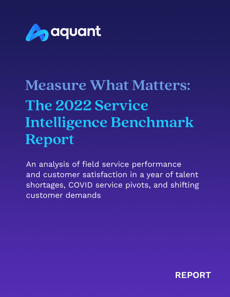
This feature is just one short excerpt from a report published by Aquant
www.fieldservicenews.com subscribers can read the full report now by hitting the button below.
If you are yet to subscribe you can do so for free by hitting the button and registering for our complimentary subscription tier FSN Standard on a dedicated page that provides you instant access to this white paper PLUS you will also be able to access our monthly selection of premium resources as soo as you are registered.
 Data usage note: By accessing this content you consent to the contact details submitted when you registered as a subscriber to fieldservicenews.com to be shared with the listed sponsor of this premium content Aquant who may contact you for legitimate business reasons to discuss the content of this white paper, as per the terms and conditions of your subscription agreement which you opted into in line with GDPR regulations and is an ongoing condition of subscription.
Data usage note: By accessing this content you consent to the contact details submitted when you registered as a subscriber to fieldservicenews.com to be shared with the listed sponsor of this premium content Aquant who may contact you for legitimate business reasons to discuss the content of this white paper, as per the terms and conditions of your subscription agreement which you opted into in line with GDPR regulations and is an ongoing condition of subscription.
WHAT KPI MEASUREMENTS DO AND DON'T TELL US
KPIs don't equal customer sentiment
In the Service Leader’s Guide to Workforce KPIs, we examined why workforce measurement is more critical than ever, and we defined best practices for measurement criteria.
For the 2022 Service Intelligence Benchmark Report, we went a step further. We analyzed service data to understand service performance beyond KPI measurement. We found that knowing your KPIs—by number or average performance—is not the same as understanding what those numbers reveal about customer satisfaction, employee skill level, or overall service performance. Averages don’t disclose the specific details you need to make critical service decisions.
Service KPIs by the numbers
Here’s the breakdown of how service organizations measure up against other organizations and the industry as a whole.
FTFR - First Time Fix Rate
What is it?
First Time Fix rate is one of the most popular metrics for workforce measurement. It indicates how often someone is able to fix an issue on the first try. In this report, we are measuring the FTF rate of field visits, in a 30-day window.
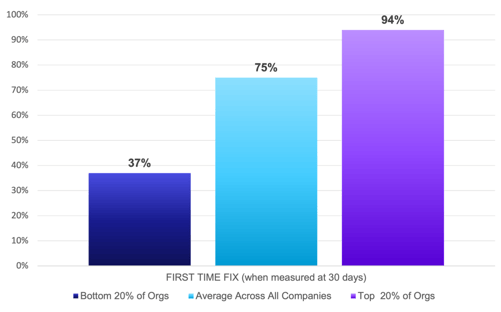
Key Observation:
FTF rates have hovered around 75% for more than a decade—and remained stagnant for all but a handful of top-performing companies. Additionally, FTF rates should never be measured in isolation. On average, a failed first visit leads to 2.5 additional visits and 20 days for MTTR.
CPS - Cost Per Success
What is it?
The total amount required to successfully close a service ticket is known as the Cost Per Success (CPS). This is a bit different from other similar-sounding KPIs, such as Cost Per Truck Roll, since total CPS may include multiple visits, multiple truck rolls, a variety of parts, and other labor costs.
Some organizations may measure Cost Per Work Order, but that metric leaves out cases that include always assigning experts to the most complex (and expensive) jobs. Additionally, it does not account for cases where multiple work orders are related to the same core issue.
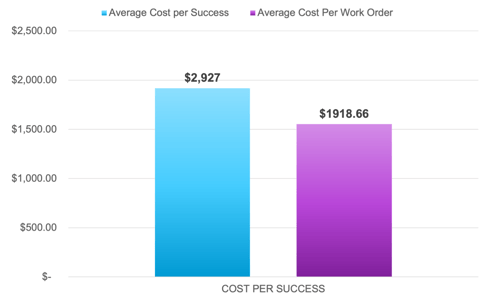
Key Observation:
Successfully resolving an issue involves nearly 42% more in costs versus looking at work orders individually. While average costs are dependent on the company and type of equipment being serviced, the cost difference is the most important to keep in mind.
MTTR - Mean Time to Resolution
What is it?
The Mean Time to Resolution KPI measures the time it takes to resolve a customer issue. Typically, it’s the time between the case creation date and the closure date. Similar to the pain of staying on hold when trying to resolve a personal issue, minimizing MTTR is a key factor in increasing positive customer experiences and reducing service costs. In the last year, we’ve seen a growing divide in this metric.
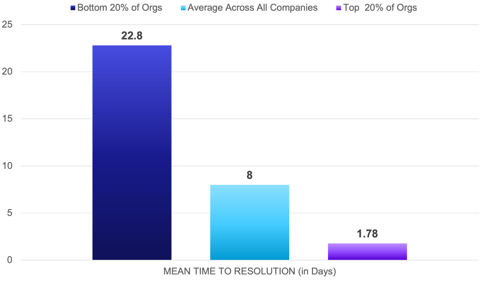
MTTR (in days):
• 8 days: average across all companies• 1.78 days: top 20% of organizations• 22.8 days: bottom 20% of organizations
MTBF - Mean Time Between Failures
What is it?
Mean Time Between Failures quantifies the average time between customer issues. Service organizations try to maximize this metric because a higher rate represents excellent service quality and maximum uptime.
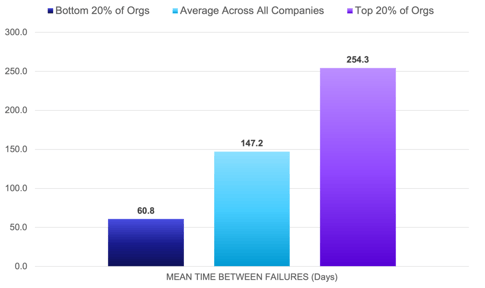
• 139.9 days: Average across all companies (147.2 in 2021)
• 231.8 days: Top 20% of organizations (254.3 in 2021)
• 57.5 days: Bottom 20% of organizations (60.8 in 2021)
Key Observation:
Individual pieces of equipment may have differing life cycles, but service leaders need to understand underlying patterns—in both their machines and workforces. When visiting a job site, experienced service heroes know how to use their time wisely and ensure that assets are working properly before leaving. This can significantly extend the time between failures.
MTBV - Mean Time Between Visits
What is it?
Need to calculate both uptime and service performance? Look no further than the Mean Time Between Visits metric. This measures every visit you have for an asset or customer, instead of only tracking time between failures.
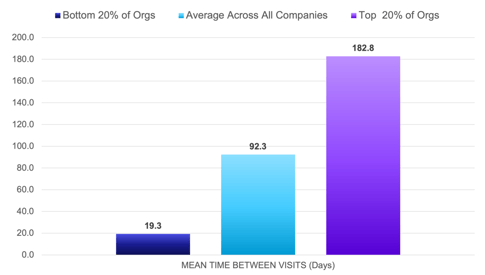
• 92.3 days: average across all companies
• 182.8 days: top 20% of organizations
<• 19.28 days: bottom 20% of organizations
Key Observation:
Experienced techs will skew towards longer time intervals between visits. That’s great news, thanks to low repeat visit rates, as well as their ability to utilize every visit to maximize uptime.

This feature is just one short excerpt from a report published by Aquant.
www.fieldservicenews.com subscribers can read the full report now by hitting the button below.
If you are yet to subscribe you can do so for free by hitting the button and registering for our complimentary subscription tier FSN Standard on a dedicated page that provides you instant access to this white paper PLUS you will also be able to access our monthly selection of premium resources as soo as you are registered.
 Data usage note: By accessing this content you consent to the contact details submitted when you registered as a subscriber to fieldservicenews.com to be shared with the listed sponsor of this premium content Aquant who may contact you for legitimate business reasons to discuss the content of this white paper, as per the terms and conditions of your subscription agreement which you opted into in line with GDPR regulations and is an ongoing condition of subscription.
Data usage note: By accessing this content you consent to the contact details submitted when you registered as a subscriber to fieldservicenews.com to be shared with the listed sponsor of this premium content Aquant who may contact you for legitimate business reasons to discuss the content of this white paper, as per the terms and conditions of your subscription agreement which you opted into in line with GDPR regulations and is an ongoing condition of subscription.
Further Reading:
- Read more about Aquant on Field Service News @ www.fieldservicenews.com/aquant
- Read more about Digital Transformation @ www.fieldservicenews.com/digital-transformation
- Read more about Leadership & Strategy @ www.fieldservicenews.com//leadership-and-strategy
- Learn more about Aquant @ www.aquant.io
- Follow Aquant on Twitter @ twitter.com/Aquant_io
Nov 17, 2021 • Features • connectivity • Digital Transformation • GLOBAL • TELENOR CONNEXION • LTE-M • NB-IOT
In the first feature of a series of excerpts from a recent white paper published by Telenor Connexion, we look at the development and evoliution of mobile connectivity technologies.
In the first feature of a series of excerpts from a recent white paper published by Telenor Connexion, we look at the development and evoliution of mobile connectivity technologies.

This feature is just one short excerpt from a white paper published by Telenor Connexion.
www.fieldservicenews.com subscribers can read the full white paper now by hitting the button below.
If you are yet to subscribe you can do so for free by hitting the button and registering for our complimentary subscription tier FSN Standard on a dedicated page that provides you instant access to this white paper PLUS you will also be able to access our monthly selection of premium resources as soo as you are registered.

Data usage note: By accessing this content you consent to the contact details submitted when you registered as a subscriber to fieldservicenews.com to be shared with the listed sponsor of this premium content Telenor Connexion who may contact you for legitimate business reasons to discuss the content of this white paper, as per the terms and conditions of your subscription agreement which you opted into in line with GDPR regulations and is an ongoing condition of subscription.
Connectivity is a crucial part of product design and performance and the choice of connectivity technology must be considered early in the process. This is a challenging choice given the quick technology and market development. 5G technologies are around the corner, 2G and 3G networks are starting to be phased out and new network technologies that support LPWAN are starting to become globally available in the form of LTE-M and NB-IoT- also referred to as Mobile IoT.
For the first time networks have been developed to answer to the specific needs of connecting things. Previously, connected units have been communicating on infrastructure developed for consumer needs.
LTE-M and NB-IoT are standardized, secure, and operator-managed in licensed spectrum. They are designed for IoT applications that are low cost, use low data rates, require long battery lives and often operate in locations that are hard to reach.
LTE-M and NB-IoT will be the obvious choices for industries looking for 2G and 3G replacements for devices with long lifecycles, requiring extended device battery life and coverage.
Both technologies are good choices for deployments with expected lifespans of a decade or more, however there are differences between them which make each of them more suitable for some IoT applications rather than others.
So which one is the best choice for your application?
This guide describes the relative benefits and limitations of each technology to help enterprises to make the right selection for long-term success.

Here's a short overview of the development of mobile connectivity technologies. Mobile connectivity has evolved from being the infrastructure for human communication to telemetry, machine-to-machine and the internet of things applications.
-
The first version of mobile connectivity – 1G – introduced wireless voice.
-
In 2G, roaming and SMS messaging were introduced and were later enhanced with GPRS for data communication. SMS messaging and GPRS became widely used for basic telemetry. Roaming made mobile technology suitable for deployments in multiple countries. Telenor was one of the first operators to offer M2M communications with things connected over the 2G network as early as the 1990s.
-
3G became a truly global standard and combined the best of competing technologies in a single standard. 3G evolutions were mainly centered around high speed data applications.
-
4G introduced LTE technology used for devices constantly connected to the internet. 4G answered the consumer need for bandwidth and speed and introduced a new way to handle voice, replacing 2G voice.
-
LTE-M and NB-IoT (Mobile IoT) are especially designed for the Internet of Things. LTE-M and NB-IoT support devices that need a long battery life and devices that need good network access in areas that are difficult to reach.
- 5G networks use a combination of existing 4G LTE and new 5G New Radio (5G NR) technology. 4G and 5G have been designed to co-exist and applications designed for 4G, including LTE-M and NB-IoT, can be expected to have a very long life. Today most networks that claim to be 5G networks are in fact using 4G LTE.
- 5G enhances 4G in three main use case areas; enhanced mobile broadband, critical communications and mobile IoT.
-
Enhanced mobile broadband is currently targeted towards consumers that need ever-increasing bandwidth. It also enables new IoT use cases that require high data volumes, for example streaming video.
-
Critical communications demands a much faster response and increased quality of service and security. 5G introduces 5G New Radio Technology which uses a higher radio frequency.
-
Mobile IoT - LTE-M and NB-IoT - are forward compatible with the 5G NR technology, which means that LTE-M and NB-IoT technology can be used throughout the complete 5G life cycle.

This feature is just one short excerpt from a white paper published by Telenor Connexion.
www.fieldservicenews.com subscribers can read the full white paper now by hitting the button below.
If you are yet to subscribe you can do so for free by hitting the button and registering for our complimentary subscription tier FSN Standard on a dedicated page that provides you instant access to this white paper PLUS you will also be able to access our monthly selection of premium resources as soo as you are registered.
 Data usage note: By accessing this content you consent to the contact details submitted when you registered as a subscriber to fieldservicenews.com to be shared with the listed sponsor of this premium content Telenor Connexion who may contact you for legitimate business reasons to discuss the content of this white paper, as per the terms and conditions of your subscription agreement which you opted into in line with GDPR regulations and is an ongoing condition of subscription.
Data usage note: By accessing this content you consent to the contact details submitted when you registered as a subscriber to fieldservicenews.com to be shared with the listed sponsor of this premium content Telenor Connexion who may contact you for legitimate business reasons to discuss the content of this white paper, as per the terms and conditions of your subscription agreement which you opted into in line with GDPR regulations and is an ongoing condition of subscription.
Further Reading:
- Read more about Digital Transformation @ www.fieldservicenews.com/digital-transformation
- Read more about Mobile Connectivity @ www.fieldservicenews.com/connectivity
- Read more about Telenor on Field Service News @ www.fieldservicenews.com/telenor
- Learn more about Telenor Connexion @ www.telenorconnexion.com
- Follow Telenor Connexion on Twitter @ twitter.com/t_connexion
- Connect with Telenor Connexion on LinkedIn @ www.linkedin.com/telenor-connexion-ab/
Nov 16, 2021 • Features • White Paper • Digital Transformation • Exel Computer Systems • Data Management
In this final feature from a recent white paper we published in partnership with Exel Computer Systems, we shall take a look at consideration for ensuring the platform you select is one you can have faith in.
In this final feature from a recent white paper we published in partnership with Exel Computer Systems, we shall take a look at consideration for ensuring the platform you select is one you can have faith in.

This feature is just one short excerpt from a recent white paper we published in partnership with Exel Computer Systems.
www.fieldservicenews.com subscribers can read the full white paper now by hitting the button below.
If you are yet to subscribe you can do so for free by hitting the button and registering for our complimentary subscription tier FSN Standard on a dedicated page that provides you instant access to this white paper PLUS you will also be able to access our monthly selection of premium resources as soo as you are registered.

Data usage note: By accessing this content you consent to the contact details submitted when you registered as a subscriber to fieldservicenews.com to be shared with the listed sponsor of this premium content Exel Computer Systems who may contact you for legitimate business reasons to discuss the content of this white paper, as per the terms and conditions of your subscription agreement which you opted into in line with GDPR regulations and is an ongoing condition of subscription.
As we have seen in the paper so far, there are a lot of benefits to the platform approach. However, there is one significant draw that can cause hesitancy in many companies – relying on one provider.
In the concluding part of this paper, we shall take a look at consideration for ensuring the platform you select is one you can have faith in...
Reliance on a single solution provider is, of course, the natural counterbalance of having one platform and one provider being integral to so many mission critical aspects of your business. For every company, the
decision as to whether the risk/reward ratio of taking the platform approach is suitable may be different.
However, having provided a small outline of just some of the benefits of the platform approach, in this concluding section of this paper we shall outline some of the key considerations that could help you mitigate risk on the other side of the equation.
When considering any platform provider you should consider the following:
WHAT IS THEIR TRACK RECORD OF WORKING WITH ORGANISATIONS LIKE MINE?
This should always be the starting point – how well will this company genuinely understand our needs? However, this doesn’t necessarily mean that you should be looking at a solution provider that only serves your particular industry vertical, or even one that caters to companies of similar size, be it enterprise or SMB.
One of the most consistent themes within Field Service News discussion groups is that so many of the pain points of field service operations are shared across vertical industries. Yet, the insight from outside your vertical sector can often help reflect on a problem – and show ways to overcome it from a new perspective.
Similarly, there are learnings from smaller, more nimble organisations that can help larger companies; and best practices of the enterprise that SMBs can adopt to improve efficiencies.
The solution provider who has that broad experience across different industry verticals, with clients of all sizes that can demonstrate that they not only understand the challenges you face but also that they have helped companies with similar needs, will be worth their weight in gold when it comes to not only improving your workflow but, perhaps most importantly, guiding you to avoid the common pitfalls you might otherwise have faced.
DO THEY HAVE A SOLID FINANCIAL POSITION?
This next consideration is essential for two key reasons. The first and perhaps more prominent of the two is that the last thing you want is to implement a solution across your business only for the provider to cease trading a year or two down the line, leaving you with what will quickly become an outdated legacy product that ultimately will cause more harm than good.
So the first key is to assess the long-term financial health of the business. Generally, if a solution provider is financially robust, this will be woven into their sales pitch at some level, but never be afraid to ask. Additionally, a look through their current customer roster can be a strong indicator of business strength. Many companies using the product, including some with strong brand recognition, can often be another indicator of a healthy and profitable business.
However, the second reason this is a crucial consideration is probably even more critical. A solid and healthy balance sheet allows for consistent investment into research and development.
For example, Exel Computer Systems solutions are under continuous development and have been since inception – the development never ends – one of the key reasons they have such strong loyalty within their customer base.
SHAPING THE FUTURE DEVELOPMENT ROADMAP
Another aspect for consideration that leads neatly on from this is understanding how responsive the solution provider is to customer input in terms of future developments?
This is an area where perhaps you may be better served by selecting a platform provider that is more accessible than the behemoths of the tech industry that may be the more appealing at first glance.
Does the solution provider host regular user groups? Is there a mechanism for feature requests? What is the success of such programs?
These are all questions that can indicate how responsive the platform provider may be to working with you to enhance further and refine the solution, or even introduce new modules to the platform entirely.
IS THE PLATFORM MODULAR?
This brings us to our final point for consideration – does the platform have a modular structure?
As we mentioned at the top of this section, there are many shared pain points across the field service sector. However, every business remains unique, and every company will have different needs.
Introducing new modules as additional requirements arise can allow a platform to offer the easy data flow we discussed in the first section of this paper, yet provide the flexibility that we often see as a highly celebrated benefit of a best- of-breed technology stack approach.
A modular-based platform also allows for more straightforward implementation. The old maxim that you can’t boil the ocean is especially true for mission-critical software implementation. The possibility of easing the implementation with a modular platform, particularly if deployed across multiple business units, allows for a much smoother transition.
"The old maxim that you can’t boil the ocean
is especially true for mission-critical software implementation..."

This feature is just one short excerpt from a recent white paper we published in partnership with Exel Computer Systems..
www.fieldservicenews.com subscribers can read the full white paper now by hitting the button below.
If you are yet to subscribe you can do so for free by hitting the button and registering for our complimentary subscription tier FSN Standard on a dedicated page that provides you instant access to this white paper PLUS you will also be able to access our monthly selection of premium resources as soo as you are registered.
 Data usage note: By accessing this content you consent to the contact details submitted when you registered as a subscriber to fieldservicenews.com to be shared with the listed sponsor of this premium content Exel Computer Systems who may contact you for legitimate business reasons to discuss the content of this white paper, as per the terms and conditions of your subscription agreement which you opted into in line with GDPR regulations and is an ongoing condition of subscription.
Data usage note: By accessing this content you consent to the contact details submitted when you registered as a subscriber to fieldservicenews.com to be shared with the listed sponsor of this premium content Exel Computer Systems who may contact you for legitimate business reasons to discuss the content of this white paper, as per the terms and conditions of your subscription agreement which you opted into in line with GDPR regulations and is an ongoing condition of subscription.
Further Reading:
- Read more about Digital Transformation @ www.fieldservicenews.com/digital-transformation
- Read more about Data Management @ www.fieldservicenews.com/data-management
- Read more about Exel Computer Systems on Field Service News @ www.fieldservicenews.com/exel
- Learn more about Exel Computer Systems @ www.exel.co.uk
- Follow Exel Computer Systems on Twitter @ twitter.com/exelcomputersys
Nov 15, 2021 • News • BigChange • Leadership and Strategy • EMEA • field service industry • Field Service Expo
During our Field Service Expo, which took place in Birmingham on 27th and 28th of October, BigChange held a presentation discussing the findings of a major research project that the company has conducted about the state of UK's field service sector.
During our Field Service Expo, which took place in Birmingham on 27th and 28th of October, BigChange held a presentation discussing the findings of a major research project that the company has conducted about the state of UK's field service sector.
Nick Gregory, Chief Marketing Officer at BigChange, discussed how the company has performed a health check of the status of the UK's field service sector to better understand the impact of the pandemic in the industry, how businesses have fared since COVID-19 restrictions have been lifted and what challenges and opportunities field service organisations are facing today.
If you haven't been able to attend our event, you can now watch BigChange's presentation by clicking below.
Data usage note: By accessing this content you consent to the contactdetails submitted when you registered as a subscriber to fieldservicenews.com to be shared with the listed sponsor of this premium content BigChange who may contact you for legitimate business reasons to discuss the content of this video, as per the terms and conditions of your subscription agreement which you opted into in line with GDPR regulations and is an ongoing condition of subscription.
Further Reading:
- Read more about Leadership & Strategy @ www.fieldservicenews.com/leadership-and-strategy
- Read more about the impact of COVID-19 in the Field Service industry @ www.fieldservicenews.com/covid-19
- Read more about BigChange on Field Service News @ www.fieldservicenews.com/bigchange
- Learn more about BigChange @ www.bigchange.com
- Follow BigChange on Twitter @ twitter.com/bigchangeapps
Nov 12, 2021 • Features • White Paper • FieldAware • Leadership and Strategy • customer experience • customer success
In the second feature from a recent white paper we published in partnership with FieldAware, we analyse the need of a shift in management structure for service organisations with a customer success focused model.
In the second feature from a recent white paper we published in partnership with FieldAware, we analyse the need of a shift in management structure for service organisations with a customer success focused model.

This feature is just one short excerpt from a recent white paper we published in partnership with FieldAware.
www.fieldservicenews.com subscribers can read the full white paper now by hitting the button below.
If you are yet to subscribe you can do so for free by hitting the button and registering for our complimentary subscription tier FSN Standard on a dedicated page that provides you instant access to this white paper PLUS you will also be able to access our monthly selection of premium resources as soo as you are registered.

Data usage note: By accessing this content you consent to the contact details submitted when you registered as a subscriber to fieldservicenews.com to be shared with the listed sponsor of this premium content FieldAware who may contact you for legitimate business reasons to discuss the content of this white paper, as per the terms and conditions of your subscription agreement which you opted into in line with GDPR regulations and is an ongoing condition of subscription.
Suppose we consider customer success more in line with a servitization model than simply increasing CSAT metrics. In that case, we may start to see a more straightforward path towards developing the model. However, this
also leads us to conclude that such a shift in focus for a service organization will require significant changes within processes and potentially a change in management structure.
The established servitization models are centred around establishing long- standing partnerships between the service provider and the customer. Indeed, as we look at many of the high-profile examples of servitization, often in the early adoption of such service strategies, not only is customer selection crucial, very often, the evolution of the service model is one of genuine co-creation.
One acknowledged approach in developing such forward looking service design is establishing a tiger team – a group of specialists dedicated to the project full- time. In the co-creation model, such a team can comprise both organizations bringing in their specialist expertise, knowledge and insight. Additionally,
both organizations also develop the new approach parallel to existing service agreements, which is especially important when considering the mission-critical status that field service operations hold.
However, once the proof of concept is established, should the service provider wish to roll out a more comprehensive servitized offering, a clear management structure to facilitate the effective rollout is required.
We would expect to see an executive-level leader at the top of this structure – ideally reporting directly to the CEO.
Such a position may come in several guises. One option is the role of a chief revenue officer (CRO), which we are beginning to see emerge as a blend of the two roles of Chief Service Officer and Chief Sales Officer.
Another alternative could be Vice President of Customer Success. For ease of reference, we shall use the term CRO in this paper. Regardless of the name, the function of the role remains the same.
This is a position that requires an intimate understanding of where the value proposition of the service provider lies within the eyes of the customer (to drive successful approaches to revenue generation), while simultaneously having detailed knowledge of how the service operations can effectively meet the service delivery requirements while retaining efficiency both in terms of internal costs but also meeting the customer goals.
In addition to both of these skillsets, the potential CRO must also have the broader business acumen and insight to see how such a move will impact and draw upon other aspects of the organization as well – from R&D through to marketing.
Beneath the CRO, a hypothetical management structure could be mapped out into three key areas as per the graphic below.
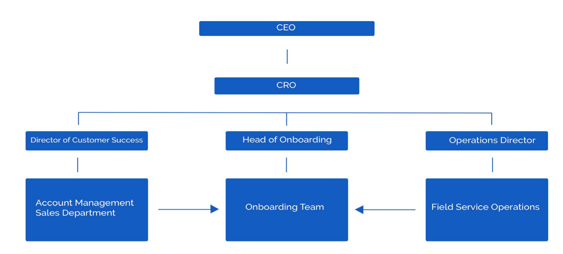
On the left-hand side, we have a customer success team led by a director of customer success.
This would be a business division that evolves from the traditional sales team – with a heavier emphasis from account management on customer success and account development – i.e. building those long-standing, more deeply embedded relationships discussed earlier.
On the right-hand side, this structure is where our service operations business unit sits under the leadership of an operations director.
On this side of the operation, the shift in focus is perhaps less pronounced than the sales operation. In one sense, little changes in seeking the maximum efficiency and operational metrics such as technician utilization, mean-time-to- repair and first-time-fix rates remain as crucial as ever.
Ultimately, even in a fully servitized business model, the SLAs to be adhered to remain the same; however, they move from being an external agreement with the customer to being an internal requirement designed to allow the service operation to meet the guarantees of uptime that are now the bedrock of service contract.
However, we see a potential new business unit emerge in the centre of this new management structure – one dedicated to onboarding. In this case, it is also important to note that onboarding isn’t limited to new customers.
" While a similar structure could be adopted for various types of servitized offering, be it outcome-based service or a customer success focused model, the evolutionary leap from a csat focus will very likely involve both executive- level support and some restructuring of management structure..."
Most service organizations adopting such an approach will be taking their existing customers from a service model that they have been comfortable with for a long time to a far more holistic and encompassing model of service delivery.
Such significant change will almost always face some form of resistance. It is essential to have this interim team in place to help guide the customers through the transition from what is often a transactional relationship initially to one that becomes a true partnership.
Ideally, this onboarding team will bring a blend of in-depth operational experience and fantastic account management skills. A recommended approach could be to draw from both the operations and sales sides of the business to establish this new business unit.
This is, of course, just one hypothetical and fairly straightforward management structure to help illustrate the point. Many more complex variations could be implemented to achieve the effective development of a servitized or customer success-focused business model.
What is clear, though, is that while a similar structure could be adopted for various types of servitized offering, be it outcome-based service or a customer success focused model, the evolutionary leap from a CSAT focus will very likely involve both executive-level support and some restructuring of management structure.
Another critical aspect essential to the successful adoption of such a model is the easy flow of data across business units and the proper technological infrastructure to ensure that the service operation can operate at maximum efficiency – which we will discuss in the next feature from this white paper.

This feature is just one short excerpt from a recent white paper we published in partnership with FieldAware..
www.fieldservicenews.com subscribers can read the full white paper now by hitting the button below.
If you are yet to subscribe you can do so for free by hitting the button and registering for our complimentary subscription tier FSN Standard on a dedicated page that provides you instant access to this white paper PLUS you will also be able to access our monthly selection of premium resources as soo as you are registered.
 Data usage note: By accessing this content you consent to the contact details submitted when you registered as a subscriber to fieldservicenews.com to be shared with the listed sponsor of this premium content FieldAware who may contact you for legitimate business reasons to discuss the content of this white paper, as per the terms and conditions of your subscription agreement which you opted into in line with GDPR regulations and is an ongoing condition of subscription.
Data usage note: By accessing this content you consent to the contact details submitted when you registered as a subscriber to fieldservicenews.com to be shared with the listed sponsor of this premium content FieldAware who may contact you for legitimate business reasons to discuss the content of this white paper, as per the terms and conditions of your subscription agreement which you opted into in line with GDPR regulations and is an ongoing condition of subscription.
Further Reading:
- Read more about Digital Transformation @ www.fieldservicenews.com/digital-transformation
- Read more about Data Management @ www.fieldservicenews.com/data-management
- Read more about FieldAware on Field Service News @ www.fieldservicenews.com/exel
- Learn more about FieldAware @ www.fieldaware.com
- Follow FieldAware on Twitter @ twitter.com/fieldaware
Nov 11, 2021 • Features • Digital Transformation • Aquant • Covid-19 • customer experience
Aquant, has recently published the 2022 Service Intelligence Benchmark Report, now available at Field Service News, which offers an in-depth analysis of field service performance and customer satisfaction in a year of talent shortage, COVID service...
Aquant, has recently published the 2022 Service Intelligence Benchmark Report, now available at Field Service News, which offers an in-depth analysis of field service performance and customer satisfaction in a year of talent shortage, COVID service pivots, and shifting customer demands.

This feature is just one short excerpt from a report published by Aquant
www.fieldservicenews.com subscribers can read the full report now by hitting the button below.
If you are yet to subscribe you can do so for free by hitting the button and registering for our complimentary subscription tier FSN Standard on a dedicated page that provides you instant access to this white paper PLUS you will also be able to access our monthly selection of premium resources as soo as you are registered.
 Data usage note: By accessing this content you consent to the contact details submitted when you registered as a subscriber to fieldservicenews.com to be shared with the listed sponsor of this premium content Aquant who may contact you for legitimate business reasons to discuss the content of this white paper, as per the terms and conditions of your subscription agreement which you opted into in line with GDPR regulations and is an ongoing condition of subscription.
Data usage note: By accessing this content you consent to the contact details submitted when you registered as a subscriber to fieldservicenews.com to be shared with the listed sponsor of this premium content Aquant who may contact you for legitimate business reasons to discuss the content of this white paper, as per the terms and conditions of your subscription agreement which you opted into in line with GDPR regulations and is an ongoing condition of subscription.
In this comprehensive data report, Aquant analyzed how service organizations and their workforce measureD up against industry benchmarks.
We also explored service performance from a customer perspective. Aquant analyzed more than six million service tickets to reveal:
-
A snapshot of the overall industry and how companies measure up against each other
-
The reason why hitting your KPIs rarely equates to outstanding customer experiences
-
The spiraling impact of a missed First Time Fix (FTF) event
-
An increase in the workforce skills gap
-
COVID-19’s impact on service
We provide recommendations to:
-
Start making immediate business improvements by looking at service performance in a comprehensive way
-
Boost the customer experience in the short-term and long-term
-
Upskill a team in the face of a talent shortage
-
Succeed amid post-Covid service disruptions
KEY FINDINGS
KPIs Are Only as Meaningful As How You Measure Them
First Time Fix is a Distorted Barometer of Service Quality
Organizations that monitor KPIs in isolation may think they are hitting their numbers and providing great service. However, there’s a good chance that they are providing sub-par customer experiences.
Organizations that measure FTF rates at seven days or 14 days actually have much lower long-term success rates than their dashboards reveal. This is because fixes marked as complete on day one often require additional visits on day two through day 14 to fix a persistent problem that may have been incorrectly or inadequately addressed on the first visit. For example, if you wrap a leaking hose with duct tape to stop a leak, you’ve put a bandaid on a problem without fixing the root issue. The customer may call to reopen that ticket when they discover another leak in the following week.
-
86.6% is the FTF rates when measured in 7-day windows
-
81.5% is the FTF rates when measured in 14-day windows
-
75% is the FTF rates when measured in 30-day windows
The other argument against relying too heavily on FTF rates is that high values often mask other issues, such as:
-
Employees who shotgun parts to hit KPIs
- High labor costs due to labor to over-reliance on industry veterans
The way organizations provide service today is not in tune with customer expectations. Even with an average FTF rate, one in every four jobs requires at least one repeat visit.
Variations on FTF measurements are one reason for the disconnect. Other contributing factors include:
- Lack of insights into an organization’s core health
- A workforce labor shortage
- Inability to connect the dots between service performance and customer experience
- Reactive vs. proactive service
In 2021, service organizations faced even larger hiring challenges than in the past. This has left the industry with tens of thousands of unfilled jobs, and some reports estimate there will be an industry-wide shortage of three million skilled trade workers in the next five years.
-
The bottom quarter of the workforce costs organizations 84% more than the top quarter. That’s 4% higher than last year.
-
- The top 20% of the workforce (service heroes) has a 75% FTF rate. The bottom 20% of the workforce (service challengers) has a FTF rate of 59%.
Mean Time to Resolution (MTTR) increased during COVID, showing that jobs were completed faster. Part of that increase is attributed to more service organizations adopting remote resolution technology. This technology helps customers address minor issues themselves through self-service solutions. It also enables service organizations to diagnose—and even repair—issues without the need to send a tech on-site, thus reducing time and costs.
This is also a sign of resiliency across service organizations, many of whom were able to adapt in the face of ever-changing circumstances.
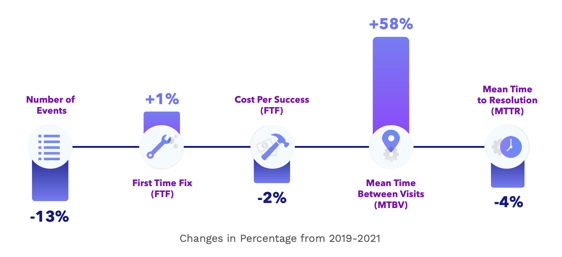
The insights in this report, gleaned from actual service data, provides a path to service improvements through a multi-step process.
-
Learn how to accurately identify your organization’s core service problems by better understanding the patterns in your service data
-
Use those data patterns to drive actionable service recommendations—for management-level decisions and in-the-field fixes
-
Plan proactive customer experience enhancements
-
Make more informed workforce training and hiring decisions to shrink the skills gap
How We Compiled the Data
Aquant gathered and analyzed actual anonymized service data from more than 76 leading service organizations. The data in this report was measured before an organization deployed Aquant’s AI solution.
The report measures:
- 76 organizations, including service divisions within OEMs and third- party service organizations across manufacturing, medical devices, capital equipment, HVAC, commercial appliances, and more
- More than 6 million work orders
- More than 31,000 technicians
- $7 billion total in service costs
- An average of 3 years of service data per company
 How We Define the Service Workforce
How We Define the Service Workforce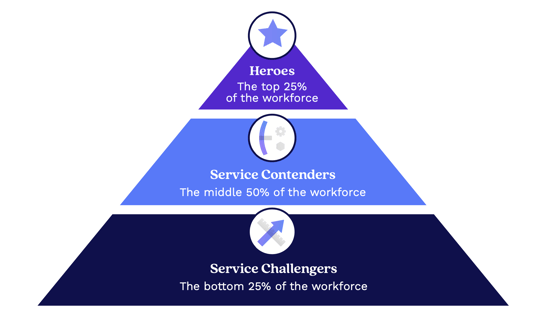 How is this Report Different from Standard Service Benchmarks?
How is this Report Different from Standard Service Benchmarks?• We analyzed real service data to understand the health and outlook of organizations instead of relying on service executives to self-report KPIs. Data sources included service tickets, CRM data, parts information, and more.
• We charted the skills gap. This makes it easy to extrapolate how much an organization can gain in efficiency and cost savings if the entire workforce was able to perform more like your experts.
• We analyzed the data using the Aquant Service Intelligence Platform, which includes a Natural Language Processing (NLP) engine built for the service industry. This lets us dig deep into data ranging from CRM and parts inventory to service tickets, handwritten records, and other information that never makes it into any databases. We are able to draw out patterns and recommendations based on raw data.

This feature is just one short excerpt from a report published by Aquant.
www.fieldservicenews.com subscribers can read the full report now by hitting the button below.
If you are yet to subscribe you can do so for free by hitting the button and registering for our complimentary subscription tier FSN Standard on a dedicated page that provides you instant access to this white paper PLUS you will also be able to access our monthly selection of premium resources as soo as you are registered.
 Data usage note: By accessing this content you consent to the contact details submitted when you registered as a subscriber to fieldservicenews.com to be shared with the listed sponsor of this premium content Aquant who may contact you for legitimate business reasons to discuss the content of this white paper, as per the terms and conditions of your subscription agreement which you opted into in line with GDPR regulations and is an ongoing condition of subscription.
Data usage note: By accessing this content you consent to the contact details submitted when you registered as a subscriber to fieldservicenews.com to be shared with the listed sponsor of this premium content Aquant who may contact you for legitimate business reasons to discuss the content of this white paper, as per the terms and conditions of your subscription agreement which you opted into in line with GDPR regulations and is an ongoing condition of subscription.
Further Reading:
- Read more about Aquant on Field Service News @ www.fieldservicenews.com/aquant
- Read more about Digital Transformation @ www.fieldservicenews.com/digital-transformation
- Read more about Leadership & Strategy @ www.fieldservicenews.com//leadership-and-strategy
- Learn more about Aquant @ www.aquant.io
- Follow Aquant on Twitter @ twitter.com/Aquant_io
Nov 09, 2021 • Features • White Paper • Digital Transformation • Exel Computer Systems • Data Management
In the second feature from a recent white paper we published in partnership with Exel, we outline how an API works and why service organisations should invest in a series of best-of-breed solutions and combine them all in a technology stack.
In the second feature from a recent white paper we published in partnership with Exel, we outline how an API works and why service organisations should invest in a series of best-of-breed solutions and combine them all in a technology stack.

This feature is just one short excerpt from a recent white paper we published in partnership with Exel Computer Systems.
www.fieldservicenews.com subscribers can read the full white paper now by hitting the button below.
If you are yet to subscribe you can do so for free by hitting the button and registering for our complimentary subscription tier FSN Standard on a dedicated page that provides you instant access to this white paper PLUS you will also be able to access our monthly selection of premium resources as soo as you are registered.

Data usage note: By accessing this content you consent to the contact details submitted when you registered as a subscriber to fieldservicenews.com to be shared with the listed sponsor of this premium content Exel Computer Systems who may contact you for legitimate business reasons to discuss the content of this white paper, as per the terms and conditions of your subscription agreement which you opted into in line with GDPR regulations and is an ongoing condition of subscription.
In the previous feature from this white paper, we looked at how the easy flow of data across various modules within a platform can improve both the efficiency of your service delivery and ensure you are meeting your customers’ expectations. However, in a world of APIs where everything is expected to work wonderfully and connect via plug and play, why shouldn’t a service organisation invest in a series of best-of-breed solutions and combine them all in a technology stack?
As a starting point, let us first take a moment to better understand what an API (Application Programming Interface) actually is. Indeed, API is an acronym often thrown into a conversation but perhaps not so well understood for those of us who are not software experts.
To outline how an API works, let us take a more straightforward example.
Imagine you’re a diner in a restaurant with a menu of choices to select from. The kitchen is the part of the ‘system’ that will prepare your meal. However, you cannot just go to the kitchen and place your order directly; this would slow the Chef down and delay service for you and everyone else in the restaurant.
The critical link required for you to communicate your order to the Chef and deliver your food to your table is a waiter.
At a very rudimentary level, the waiter is an API. They are the messenger that takes your request and informs the Chef of what is needed. Then when the Chef completes the task, the waiter returns to deliver the response (in this case, your meal) back to you.
So far, so good.
However, now let’s expand the analogy to fit better the many moving parts of a mission-critical activity, such as field service. In a best-of-breed technology stack, we are no longer dealing with one waiter; we are dealing with a waiter for each aspect of the meal. One Waiter to take our order for our appertisers, another for our entrée. We have a Concierge to ensure we are sat at an adequate table, a Sommelier to take our wine order, a Dessert Waiter and so forth.
Then each of these additional waiters will be linking back to a different part of the restaurant.
The Commis Chef will be responsible for delivering one part of the meal, the Sous Chef another, Chef de Partie another. The Bartender is responsible for providing drinks expertly recommended by the Sommelier, and working in an entirely different part of the building.
Anyone who has been to a high-end restaurant will know that such complexity can be managed and delivered effectively to drive a standard of service that is exceptional.
However, anyone who has worked in such a restaurant will tell you that it takes a phenomenal amount of work to keep the lines of communication and the flow of productivity moving across the shift. Indeed, this is why good restaurant managers that can keep all of these connections, these ‘human APIs’, working in unison, are worth their weight in gold.
"With a platform approach, the links between modules are within the architecture of the solution itself, updates would have been fully tested system- wide prior to deployment. Should an issue occur, you have one point of contact to seek swift resolution..."
However, for the field service organisation, whose function is to serve their customers, not manage a complex web of systems and technology, is this an optimum approach?
In a best-of-breed technology stack, a company becomes exposed to various elements, reliant on multiple APIs being aligned across numerous updates.
As with the restaurant example, managing this takes a lot of work. Any one of the elements the stack is comprised of could become a broken link the chain, having a knock-on effect across the stack. It has to be questioned whether such a complex solution is worth the risk.
For example, if the integration between two integral systems within your technology stack fails, to which of the two providers should you turn to resolve the issue?
With a platform approach, the links between modules are within the architecture of the solution itself, updates would have been fully tested system- wide prior to deployment. Should an issue occur, you have one point of contact to seek swift resolution. With a platform approach, a lot of the responsibility shifts onto your solution provider to make things work. Of course, this also means less heavy lifting required from your internal IT team.
With the technology stack, your IT team can spend all of their time making the multiple solutions talk to each other, bouncing from one solution provider to the next in an endless cycle of updates and new integrations.
This can be a drain on resources, both financially and in terms of man-hours, both of which could be better spent focusing on growing your business and keeping your customers happy.
As we saw in the previous section, the seamless flow of data across an organisation can be the difference between service failure or service excellence.
Do you really want to be exposed to multiple potential weak links in the chain, especially when the one platform approach overcomes this?

This feature is just one short excerpt from a recent white paper we published in partnership with Exel Computer Systems..
www.fieldservicenews.com subscribers can read the full white paper now by hitting the button below.
If you are yet to subscribe you can do so for free by hitting the button and registering for our complimentary subscription tier FSN Standard on a dedicated page that provides you instant access to this white paper PLUS you will also be able to access our monthly selection of premium resources as soo as you are registered.
 Data usage note: By accessing this content you consent to the contact details submitted when you registered as a subscriber to fieldservicenews.com to be shared with the listed sponsor of this premium content Exel Computer Systems who may contact you for legitimate business reasons to discuss the content of this white paper, as per the terms and conditions of your subscription agreement which you opted into in line with GDPR regulations and is an ongoing condition of subscription.
Data usage note: By accessing this content you consent to the contact details submitted when you registered as a subscriber to fieldservicenews.com to be shared with the listed sponsor of this premium content Exel Computer Systems who may contact you for legitimate business reasons to discuss the content of this white paper, as per the terms and conditions of your subscription agreement which you opted into in line with GDPR regulations and is an ongoing condition of subscription.
Further Reading:
- Read more about Digital Transformation @ www.fieldservicenews.com/digital-transformation
- Read more about Data Management @ www.fieldservicenews.com/data-management
- Read more about Exel Computer Systems on Field Service News @ www.fieldservicenews.com/exel
- Learn more about Exel Computer Systems @ www.exel.co.uk
- Follow Exel Computer Systems on Twitter @ twitter.com/exelcomputersys






















 Field Service News is published by 1927 Media Ltd, an independent publisher whose sole focus is on the field service sector. As such our entire resources are focused on helping drive the field service sector forwards and aiming to best serve our industry through honest, incisive and innovative media coverage of the global field service sector.
Field Service News is published by 1927 Media Ltd, an independent publisher whose sole focus is on the field service sector. As such our entire resources are focused on helping drive the field service sector forwards and aiming to best serve our industry through honest, incisive and innovative media coverage of the global field service sector.
Leave a Reply